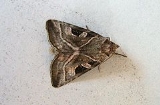
Eucarta virgo
Encyclopedia
The Silvery Gem is a moth
of the family Noctuidae
. The species can be found in South, Southeast and Central Europe
.
The wingspan
is 25-36 mm.
The larvae feed on Artemisia vulgaris
, Artemisia campestris
and Tanacetum vulgare.
Moth
A moth is an insect closely related to the butterfly, both being of the order Lepidoptera. Moths form the majority of this order; there are thought to be 150,000 to 250,000 different species of moth , with thousands of species yet to be described...
of the family Noctuidae
Noctuidae
The Noctuidae or owlet moths are a family of robustly-built moths that includes more than 35,000 known species out of possibly 100,000 total, in more than 4,200 genera. They constitute the largest family in the Lepidoptera....
. The species can be found in South, Southeast and Central Europe
Europe
Europe is, by convention, one of the world's seven continents. Comprising the westernmost peninsula of Eurasia, Europe is generally 'divided' from Asia to its east by the watershed divides of the Ural and Caucasus Mountains, the Ural River, the Caspian and Black Seas, and the waterways connecting...
.
The wingspan
Wingspan
The wingspan of an airplane or a bird, is the distance from one wingtip to the other wingtip. For example, the Boeing 777 has a wingspan of about ; and a Wandering Albatross caught in 1965 had a wingspan of , the official record for a living bird.The term wingspan, more technically extent, is...
is 25-36 mm.
The larvae feed on Artemisia vulgaris
Artemisia vulgaris
Artemisia vulgaris is one of several species in the genus Artemisia which have common names that include the word mugwort. This species is also occasionally known as Felon Herb, Chrysanthemum Weed, Wild Wormwood, Old uncle Henry, Sailor's Tobacco, Naughty Man, Old Man or St...
, Artemisia campestris
Artemisia campestris
Artemisia campestris L. is a species of herbaceous biennial or perennial plants in the genus Artemisia that grows in open sites on dry sandy soils throughout the Boreal Kingdom.-External links:** in Flora of North America...
and Tanacetum vulgare.

